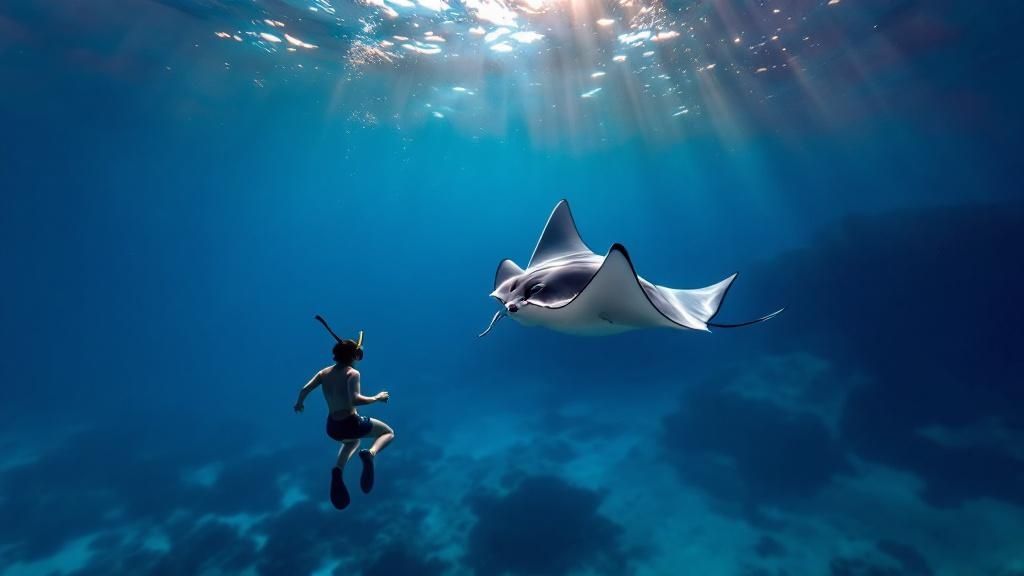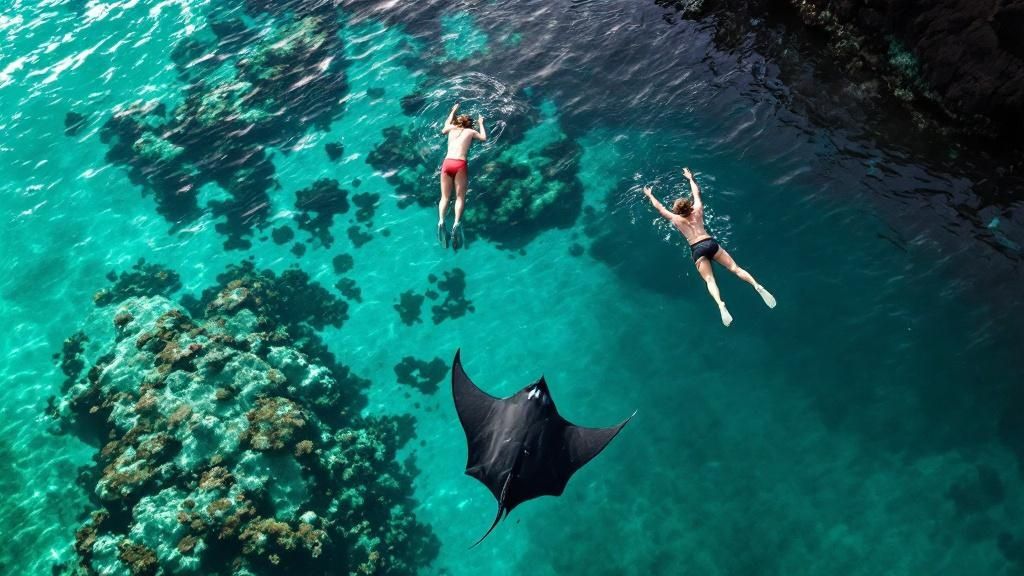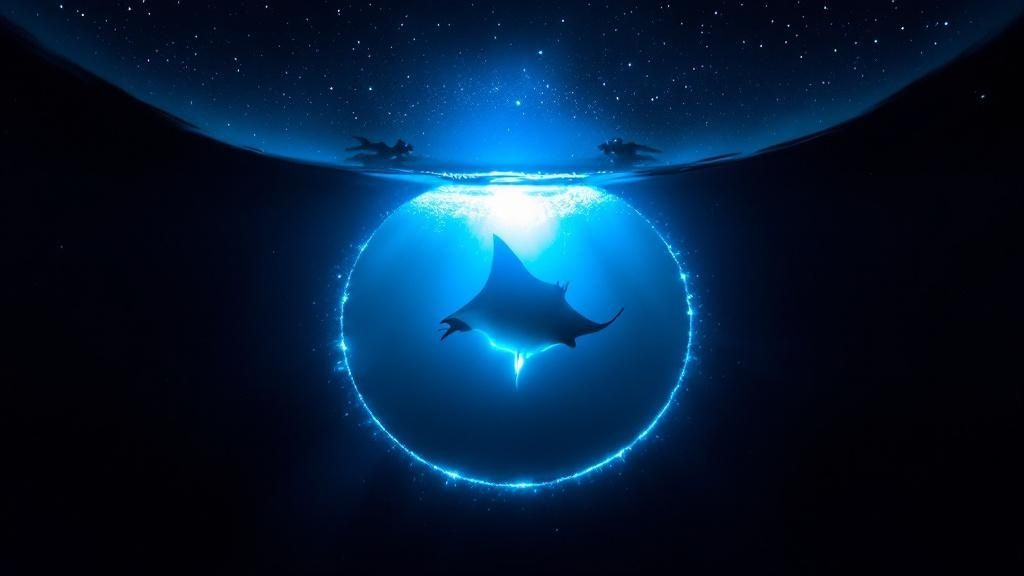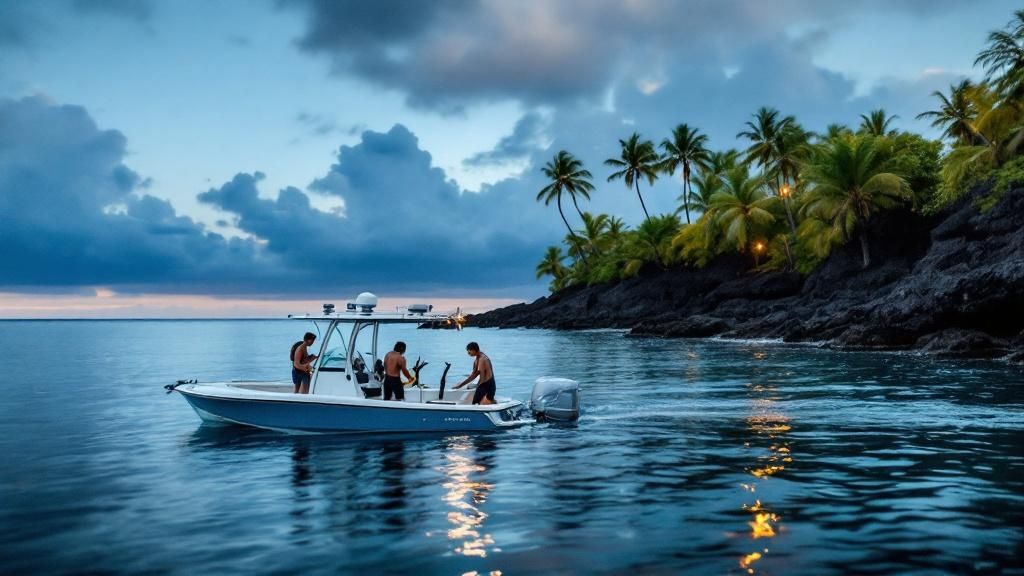Manta Ray Snorkel Big Island: Complete Guide to Encounters
- Byron
- Jun 21
- 15 min read
Why Kona Became the Manta Ray Capital of the World

The Kona coast of Hawaii’s Big Island isn't just a world-class destination for a manta ray snorkel big island tour; it's the undisputed global capital for these encounters. This celebrated status didn't happen by chance. It’s the result of a unique mix of geography, animal behavior, and a little human discovery. Think of the Big Island's coastline as a natural amphitheater for an incredible underwater ballet, with a stage set millions of years ago by volcanic activity.
This volcanic past carved out a dramatic underwater landscape. Ancient lava flows formed sheltered bays and coves with soft, sandy bottoms. These areas are shielded from the powerful currents of the open ocean and act as natural collection points. Imagine them as giant, submerged bowls where microscopic life, especially plankton, gathers. For manta rays, which feed almost exclusively on these tiny organisms, this geological setup is a reliable, five-star buffet that is open every night.
The Science Behind the Spectacle
The magic of Kona’s manta encounters boils down to a simple, yet brilliant, formula: light attracts plankton, and plankton attracts mantas. This phenomenon started decades ago when a coastal hotel began lighting up the water for its guests. Manta rays, being clever and opportunistic feeders, quickly learned that this nightly glow meant an easy meal. This conditioned behavior has been passed down through manta generations, creating a remarkably consistent gathering.
Today, tour operators recreate this effect using powerful, eco-friendly underwater lights. These lights draw in dense clouds of plankton, which in turn attract the mantas for their nightly feeding ritual. This dependable food source is the main reason encounters are so frequent. In fact, the consistency is supported by years of observation, with sighting records showing an impressive 80-90% success rate for manta ray sightings on night snorkeling trips. These numbers make encounters here far more predictable than anywhere else in the world. You can learn more about these remarkable sighting statistics and the research behind them.
A Cultural and Ecological Treasure
Beyond the science, manta rays, known as hahalua in Hawaiian, hold a special place in the local culture. They are often seen as guardians and symbols of wisdom and graceful strength. This deep-rooted respect has helped foster a community-wide commitment to their protection, which has shaped the responsible eco-tourism industry that thrives here.
The combination of ideal geography, learned feeding behavior, and a culture of conservation has made Kona a legendary destination. This unique blend is what ensures your manta ray snorkel big island adventure is not just possible, but highly probable, offering a truly magical and reliable wildlife experience. You can dive deeper into the specifics by exploring our complete guide to magical manta encounters.
Garden Eel Cove vs Keauhou Bay: Decoding the Perfect Site

The Broadway Show: Garden Eel Cove
North of Kailua-Kona, Garden Eel Cove (also called Manta Heaven) is the grand stage for manta ray viewing. It's like a bustling Broadway theater where multiple tour boats gather, aiming their lights into the water. This creates a powerful, combined glow that attracts huge clouds of plankton—the mantas' favorite food—which can lead to a spectacular feeding frenzy. It's not uncommon to see a dozen or more mantas here, gracefully swooping and barrel-rolling through the light beams.
Because it's more sheltered from open ocean swells and has more space, most tour companies prefer this location. It tends to offer a more concentrated and consistent viewing experience, with more boats and snorkelers in a relatively small area. For an idea of how often mantas are spotted, you can see the latest manta sighting data on this operator's report.
The Intimate Jazz Club: Keauhou Bay
Farther south, you'll find Keauhou Bay (often referred to as Manta Village), which feels more like an intimate jazz club. Fewer boats operate here, creating a quieter, more personal atmosphere. While you might see fewer mantas overall compared to a busy night at Garden Eel Cove, the encounters can feel incredibly close and personal. You might find a single, curious manta ray interacting with just your group for a long time, which creates its own kind of magic.
Another big advantage is the location. For tours departing from Keauhou Harbor, the boat ride to the site is much shorter. This is a significant plus for anyone who is prone to seasickness and wants to minimize their time on the water.
Site Comparison: Making the Right Choice
To help you decide which "venue" is the best fit for your adventure, here’s a straightforward comparison of the two legendary manta sites.
Feature | Garden Eel Cove | Keauhou Bay |
|---|---|---|
Location | North of Kona (near the airport) | South of Kona (in Keauhou) |
Atmosphere | High-energy, big-show spectacle with lots of activity | Intimate, quiet, and personal |
Typical Manta Count | Higher numbers are possible (5-15+) | Often fewer but very consistent (1-5) |
Boat Traffic | Can be crowded with multiple boats | Generally fewer boats, leading to a less crowded feel |
Water Conditions | More protected and generally calmer | Can be more exposed to southern swells |
Best For | Snorkelers looking for a high-energy show with the potential to see many mantas. | Those who prefer smaller crowds and potentially closer, more personal encounters. |
Ultimately, experienced tour operators make the final call each night based on the current ocean conditions, swell direction, and recent manta activity. The best approach is to stay flexible and trust your guide's expertise. Their goal is to take you to the best possible show that nature is putting on that evening, ensuring your manta ray snorkel big island experience is one you'll never forget.
Your First Manta Ray Night Snorkel: What Really Happens

The thought of floating in the open ocean after dark can sound a little nerve-wracking. However, a manta ray snorkel on the Big Island is a carefully managed experience that trades fear for fascination. It's less of a swim and more of a front-row seat to an incredible underwater ballet, with you as the quiet audience.
Your adventure starts when the tour boat anchors at a specific viewing location. The crew then deploys a large, floating light board or raft. This isn't just a handle to hold onto; it's the centerpiece of the show. Bright, eco-friendly lights are aimed down into the water, creating an irresistible beacon for the ocean's tiniest residents: plankton. These microscopic creatures flock to the light, forming a thick, glowing cloud. You and the other snorkelers will hold onto the raft, encircling this illuminated "stage" from above.
The Arrival of the Stars
At first, all you'll notice is the swirling soup of plankton in the light beams. Then, a huge, dark silhouette glides up from the blackness below. This is the moment that transforms any lingering nerves into pure wonder. The manta rays have arrived for their all-you-can-eat buffet. They are focused entirely on feeding, often passing within inches of you as they perform barrel rolls and loops through the water.
These graceful movements aren't just for show—they are powerful feeding maneuvers. You'll watch them do somersaults and backflips, which allows them to filter as much plankton-rich water as possible through their massive, open mouths. It's a mesmerizing display of nature's efficiency, and you are simply there to witness it.
What to Expect in the Water
Many newcomers are curious about what it's really like to be in the dark ocean with these giants. Here’s a breakdown:
Your World is the Light: The underwater lights create a clearly defined zone of visibility. Your attention will be completely fixed on the bright circle beneath you, making the surrounding darkness feel distant and irrelevant.
A Gentle Rhythm: You'll be floating calmly on the surface while holding the raft. Almost no swimming is required. The main instruction is to stay horizontal and keep your legs still to avoid kicking the mantas, allowing you to just watch the show.
The Manta Mindset: These are true gentle giants. Manta rays have no teeth, barbs, or stingers. As filter feeders, they are completely uninterested in you. While touching them is strictly forbidden to protect their delicate skin, they sometimes glide close enough to brush against you by accident.
The in-water portion of the tour typically lasts for about 30 to 45 minutes. One minute you might be watching a single ray, and the next, you could be surrounded by several, all engaged in their hypnotic dance. This is the heart of the manta ray snorkel big island experience—a peaceful, safe, and deeply moving encounter with one of the ocean's most magnificent creatures.
Essential Gear and Smart Preparation for Your Snorkel
A great manta ray snorkel experience on the Big Island starts well before you get on the boat. Think of it like preparing for a special nighttime performance where you're part of the show. While your tour operator will supply the main equipment, knowing what to expect and what personal items to bring can make a huge difference in your comfort. Proper preparation means you can relax and fully immerse yourself in the incredible sight of the mantas.
Mastering Your Core Equipment
Your tour will provide the essentials: a mask, snorkel, and a flotation device. A few quick checks can significantly improve your experience. Your mask is your personal window to the underwater show, so you don't want a leaky or foggy one to ruin the view. Before you even get on the boat, try this: press the mask to your face without the strap and gently inhale through your nose. If it suctions to your face, you've got a good seal.
The wetsuit is more than just an outfit; it’s your personal thermostat for the ocean. Even in Hawaii's warm waters, you can start to feel a chill after floating still for 30 to 45 minutes at night. Most tours offer "shorty" wetsuits, which cover your torso and thighs. If you know you get cold easily, it's worth asking if they have full-length suits or bringing a rash guard to wear underneath for extra warmth.
While you'll be given fins, your main job is to remain as still as possible. You will be holding onto a large, floating light board. The goal is to stay horizontal on the water's surface, keeping your legs and fins calm to avoid accidentally kicking a manta ray or another snorkeler.
The Role of Light and Pre-Trip Planning
The entire encounter is built around light. The powerful, submerged lights attached to the float board are like a beacon, attracting swarms of tiny plankton. This plankton is the manta rays' favorite meal, drawing them right to you. Your guides manage all the lighting, but it's your job to stay close to the light board, as this is where all the action unfolds.
Good planning also includes what you do in the hours leading up to the tour. If you're prone to motion sickness, it's a good idea to take an over-the-counter remedy about an hour before boarding the boat. These are much more effective when taken proactively. Also, try to have a light meal a couple of hours beforehand. Snorkeling on a stomach that's either completely full or totally empty can be uncomfortable.
To help you pack, here’s a quick checklist breaking down what’s typically provided versus what you should bring.
Manta Ray Snorkel Gear Checklist
Complete breakdown of what's provided by tour operators versus what you should bring yourself, including optional items for an enhanced experience.
Item | Provided by Tour | Bring Yourself | Importance Level |
|---|---|---|---|
Mask & Snorkel | Usually Yes | Optional (if you prefer your own) | Critical |
Wetsuit | Usually Yes | Optional (rash guard for warmth) | High |
Flotation Device | Yes | No | Critical |
Towel & Dry Clothes | No | Yes | High |
Seasickness Remedy | No | Yes | Medium |
Waterproof Camera | No | Yes | Optional |
Reusable Water Bottle | Sometimes | Yes | Medium |
Hair Ties | No | Yes | Medium |
This table shows that while the core gear is covered, your personal comfort items like a towel, dry clothes, and any seasickness medication are your responsibility. Planning for these small details ensures you have a much more pleasant trip.
Capturing the Magic: Photography Tips
Of course, you'll want to capture photos of your manta ray snorkel adventure, but this requires a specific approach. Given the dark, underwater conditions, a GoPro or another type of action camera will give you the best results. Leave your phone behind, even in a waterproof case; the camera sensor just isn't designed for this kind of low-light videography.
Here are a few tips for getting great shots:
Go Wide: Use a wide-angle setting on your camera. This is the best way to capture the enormous wingspan of the mantas as they glide by.
Keep it Stable: A wrist strap or a small float handle is essential. It keeps your camera secure, frees up your hands, and, most importantly, prevents you from dropping it into the ocean.
No Flash Allowed: This is a strict rule. Absolutely no flash photography is permitted. A sudden, bright flash can startle and disorient the manta rays, interrupting their natural feeding and spoiling the experience for everyone.
By thinking through your gear and preparing yourself ahead of time, you're setting yourself up for a comfortable, safe, and truly unforgettable encounter with Kona's majestic manta rays.
Timing Your Visit for Optimal Manta Ray Encounters

Think of it like planning a visit to a popular park. It’s always there, but your experience will be different on a calm, sunny day versus a windy one. Choosing the right time involves weighing these natural influences to find the best fit for you.
Seasonal Patterns and Ocean Conditions
In Hawaii, seasons are defined less by temperature and more by ocean energy. This directly impacts both manta behavior and how comfortable you'll be in the water.
Summer (June - August): These months usually bring the calmest seas and clearest water. With smaller waves and excellent visibility, summer is often the best time for families or anyone who isn't a strong swimmer. The boat ride to the manta site is typically smoother, too.
Winter (December - February): Winter brings bigger ocean swells, especially from the north. While that might sound intimidating, the rougher water can actually be a plus. It churns up more nutrients, concentrating plankton in the sheltered bays where the mantas feed. This can lead to a more active and spectacular feeding frenzy. The trade-off is a higher chance of trip cancellations due to rough conditions, so it pays to be flexible.
The Surprising Influence of the Moon
A factor that many people overlook is the phase of the moon. It has a real effect on the snorkel experience because the entire tour relies on bright lights to attract plankton.
New Moon: On nights with a new moon, the sky is at its darkest. This makes the tour boats' powerful underwater lights incredibly effective. The plankton are drawn to this single, intense light source, creating a concentrated buffet that often attracts more mantas.
Full Moon: During a full moon, the bright moonlight illuminates the entire water surface. This can cause the plankton to spread out instead of gathering under the boat's lights. On the flip side, the natural moonlight provides better overall visibility in the water, which can make some people feel more comfortable.
There’s no single "best" night. Experienced guides have seen amazing encounters during a full moon and slower nights during a new moon. The main point is that different conditions create slightly different, but equally amazing, experiences.
Strategic Booking and Backup Plans
Because nature is unpredictable, the smartest strategy is to book your manta ray snorkel big island tour early in your vacation. Most reputable operators offer a "manta guarantee," meaning if no mantas show up, they’ll let you rebook for free on another night.
Scheduling your trip at the beginning of your stay gives you the flexibility to use that guarantee without messing up your other plans. Always check the company's specific cancellation and re-booking policy when you reserve your spot. By planning ahead, you give yourself the best possible chance to witness this unforgettable underwater ballet.
Choosing Your Perfect Manta Ray Tour Operator
With dozens of companies offering a manta ray snorkel big island tour, picking the right one can feel a bit overwhelming. But the difference between a decent trip and an exceptional one is huge. Think of it like hiring a guide for a once-in-a-lifetime expedition—their expertise, equipment, and philosophy will shape every part of your adventure. The best operators truly stand out, and knowing what to look for is the key to making a great choice.
What Separates the Best from the Rest
The top tour operators distinguish themselves in a few critical ways. Small group sizes are a major factor. A boat with fewer people means you get more personalized attention from your guide, a better spot around the underwater lights, and a far more intimate experience with the mantas. It’s the difference between being a face in a crowd and a valued guest on an exclusive outing.
Comprehensive safety measures are also essential. This goes beyond just having life jackets on board. Premier operators employ lifeguard-certified guides, deliver thorough safety briefings, and follow strict in-water procedures to protect both you and the manta rays. This focus on the well-being of both people and animals is the mark of a truly responsible company. Finally, years of local experience give guides deep insights into manta behavior, allowing them to turn a simple snorkel trip into a fascinating educational journey.
Key Questions to Ask Before You Book
To figure out an operator's quality, it's smart to ask a few direct questions. This helps you understand what truly matters and uncovers their level of professionalism.
What is your guide-to-guest ratio? A lower number here is always better. For example, one guide for every 10-12 guests ensures a safer, more personal trip.
What is your manta sighting guarantee? Reputable companies often have a "manta guarantee," which lets you re-book for free if no mantas show up. This shows they are confident in their location and process.
How do you contribute to manta ray conservation? The best operators are actively involved in research and conservation, often following guidelines from organizations dedicated to protecting these gentle giants. Their commitment helps ensure these amazing encounters can continue for years to come.
What kind of boat do you use? Some operators have larger, more stable vessels, which are great if you're worried about seasickness. Others use smaller, zippier zodiacs for a more adventurous ride.
An operator's answers will reveal a lot about their priorities. If you want a handpicked list of trusted companies, check out our guide on the best manta ray night snorkel Kona tours to see who truly excels.
Understanding Price and Red Flags
Tour prices can vary, but this often reflects the quality you'll receive. A higher price might mean smaller groups, newer gear, or more experienced guides. On the flip side, an unusually low price can be a red flag, sometimes hinting at overcrowded boats or rushed, impersonal tours. Be cautious of operators with aggressive sales tactics or those who seem more focused on quantity over a quality wildlife experience.
Booking your tour early in your trip is a great idea. It gives you flexibility to reschedule if bad weather rolls in or if you need to use a manta guarantee. By carefully considering your options, you can select an operator whose dedication to safety and responsible tourism will make your manta ray snorkel big island adventure truly unforgettable.
Maximizing Your Manta Ray Adventure Beyond the Water
Your incredible manta ray snorkel big island experience doesn’t have to fade away once you're back on the boat. For many, that magical encounter is the start of a much deeper appreciation for our oceans. Think of your snorkel as the first chapter in a bigger story—one where you can play a part in protecting the very creatures that left you in awe.
From Memory to Meaningful Action
The feeling of a giant manta ray gliding just beneath you is unforgettable. The key is to channel that powerful moment into something that lasts. One of the best ways to do this is by participating in citizen science. By submitting your photos and videos to manta identification databases, you can help researchers track individual rays, monitor population health, and understand their migration patterns along the Kona coast.
You can also deepen your understanding through education. Visiting a local marine education center can add rich context to your adventure. These places explain the complex ecosystem that supports the mantas, from the microscopic plankton they feed on to the health of the coral reefs. Learning about this turns a beautiful memory into a deeper connection with the marine world.
Becoming an Ambassador for the Mantas
Sharing your photos and videos is a fantastic way to spread the magic, but doing so responsibly makes a real difference. When you post about your trip, mention the importance of choosing eco-friendly tour operators and practicing passive observation. This small step turns a simple social media post into a powerful educational tool.
Your experience also gives you a unique voice to support conservation. While manta tourism provides a vital economic incentive for protection, it's important to remember how vulnerable these populations are. Globally, some regional populations of giant manta rays are estimated to have as few as 600 to 2,000 individuals. This makes Kona's consistent aggregation a site of global significance. You can discover more insights about giant manta ray conservation efforts to see why this work is so critical.
Planning Your Next Chapter
Many people find that one manta ray snorkel big island trip just isn't enough. Your first time is often about the sheer spectacle, but future trips can offer a much deeper connection.
Try a different time of year: Observe the subtle seasonal shifts in manta behavior and numbers.
Visit the other primary site: If your first snorkel was at Garden Eel Cove, consider Keauhou Bay next time to experience a different setting.
Dive deeper into photography: Give yourself a new challenge by trying to capture different aspects of their graceful movements. You can learn more about how to have a great time in our article about your next underwater adventure.
By turning your memories into action, your manta ray snorkel becomes more than just a vacation highlight—it becomes a gateway to lifelong ocean advocacy, helping to ensure these gentle giants continue to grace Kona’s waters for generations.
Ready to start your journey and create memories that last a lifetime? Book your Manta Ray Night Snorkel Hawaii adventure with us today and experience the magic for yourself.
Comments